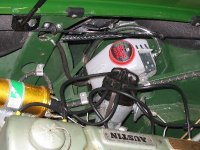Hi,
Has anyone installed a coolant recovery system? I added a flex fan to my 100-6 and it ran at a good temp during a test run but when I stopped at the store the temp increased to the point that radiator fluid belched out. After starting out again the temp went back down to the good point. My timing is 15 degrees at 600 rpm although there is some fluxuation when scoping.
Thanks,
Chuck /ubbthreads/images/graemlins/confused.gif
Has anyone installed a coolant recovery system? I added a flex fan to my 100-6 and it ran at a good temp during a test run but when I stopped at the store the temp increased to the point that radiator fluid belched out. After starting out again the temp went back down to the good point. My timing is 15 degrees at 600 rpm although there is some fluxuation when scoping.
Thanks,
Chuck /ubbthreads/images/graemlins/confused.gif

 Hi Guest!
Hi Guest!

 smilie in place of the real @
smilie in place of the real @
 Pretty Please - add it to our Events forum(s) and add to the calendar! >>
Pretty Please - add it to our Events forum(s) and add to the calendar! >> 

